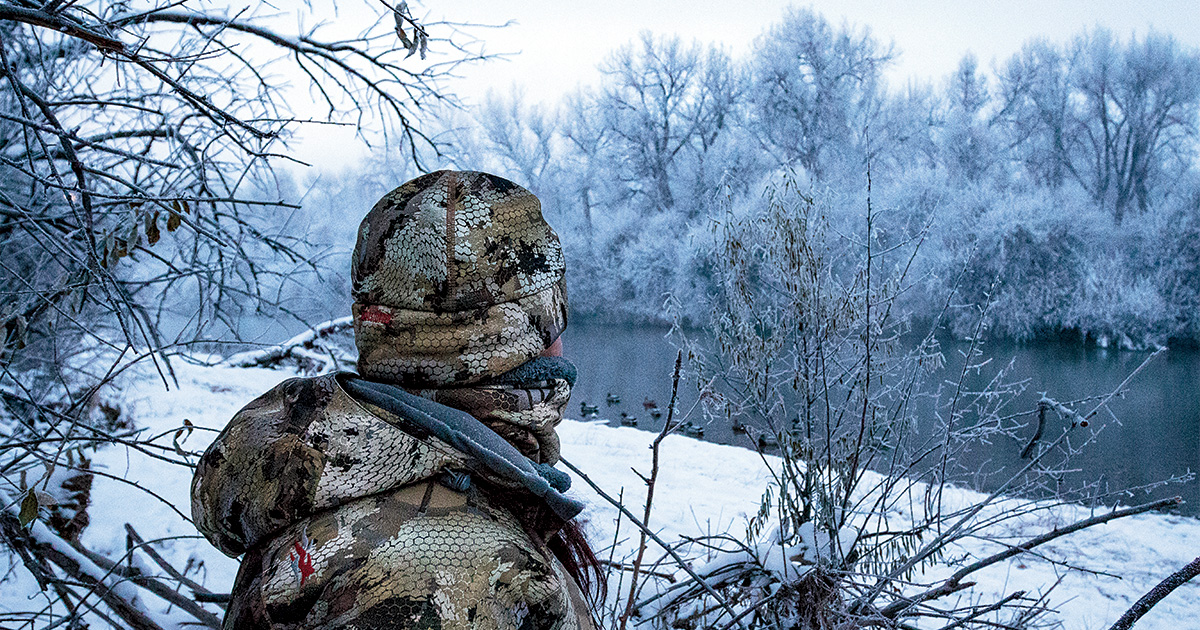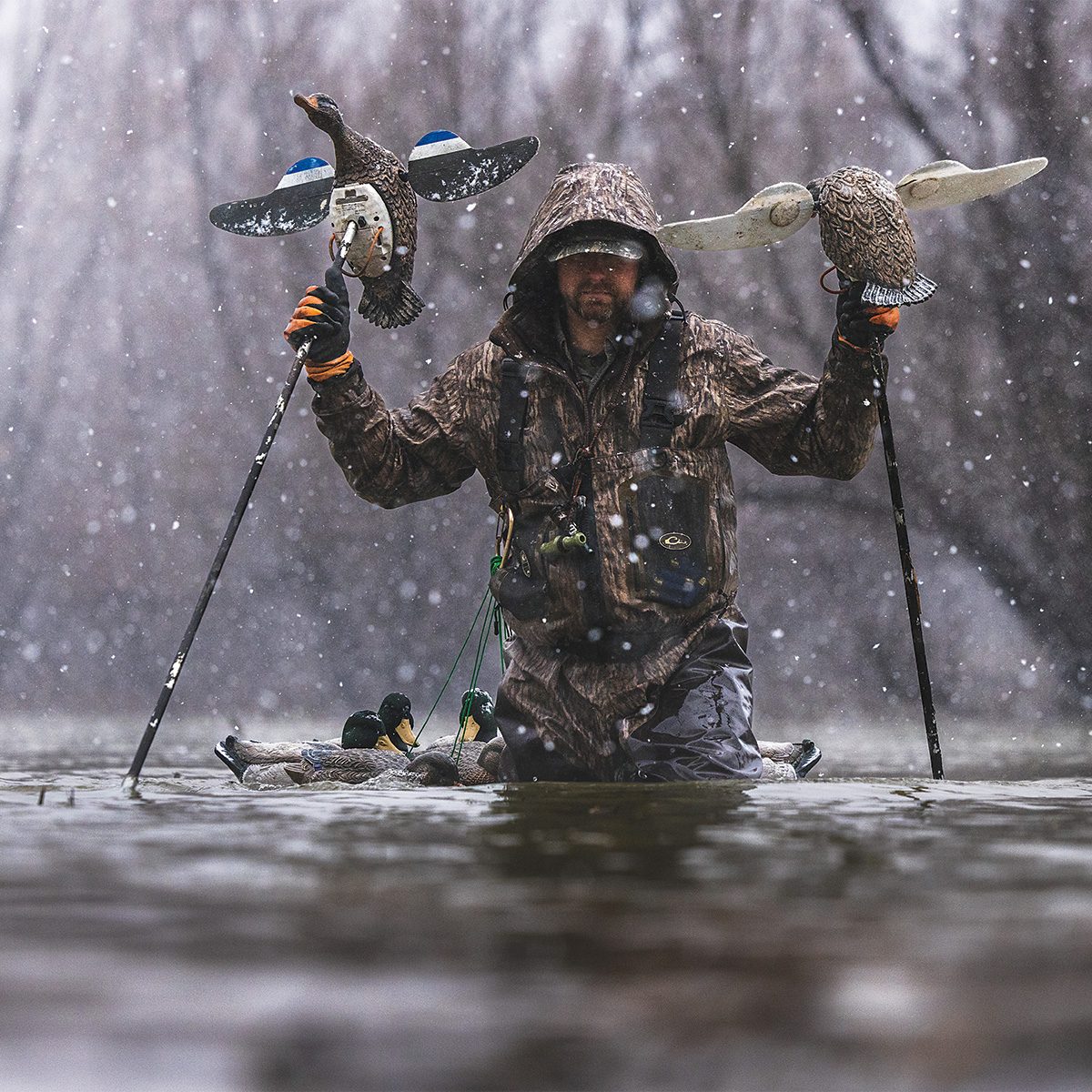Stay Safe Out There!
When late-season weather turns dangerous, pay heed to this life-saving advice
When late-season weather turns dangerous, pay heed to this life-saving advice

NO SCHOOL. Those words had just scrawled across the bottom of the TV screen, and before long I had my gun and gear in hand and was headed for the door.
“Mom, I’m going hunting,” I hollered. “I’ll be careful on the roads.”
As the youngest of four kids, I probably got away with more than I should have when I was a teenager, like somehow convincing my mother that the same winter storm blowing outside, which was serious enough to cancel school for the day, was not serious enough to keep me at home on one of the final days of the duck season. I also think she knew just how crazy I was about duck hunting.
“Be back by lunch,” she replied. “And don’t do anything dumb.”
I pointed my truck west and slid my way toward a public hunting area that contained a large wetland. I had hunted the marsh earlier in the season, leaning against a muskrat hut to shoot blue-winged teal and gadwalls. I figured that if there were any ducks left in the area, this would be where I would find them. And I did.
I pulled into the parking area, and between the swish-swish-swish of the windshield wipers I could see ducks on the marsh. When I peered through my binoculars, the birds came to life.
Mallards.
And not just any mallards. These were late-season birds. Drakes dressed in their Sunday best, with blocky heads of emerald green, chests of brown, and curls of black. These mallards were prime, and I was the only hunter around.
I waded through the grass and reached the cattails, where I peered through falling snow at the mob of mallards swimming in steel-blue waters. The large wetland was mostly frozen and covered in a dusting of snow and sleet, but the ducks had kept a small pocket of water free of ice. The birds were packed in so tightly that I didn’t think another duck could fit, but as flock after flock appeared in the gray skies above, they dropped straight down, making a slight turn into the face of a northwest wind and adding to the mass of drakes and hens on the water.
I figured that if I could position myself on the downwind side of the hole, the mallards would fly right over me as they pitched into the only open water in the area. All that stood between me and a limit of greenheads, I reckoned, was my crossing 100 yards of ice.
I punched my way through the tangle of cattails and tested the ice. It held firm. Shuffling over the frozen surface of the wetland, I made it about halfway to the open water when the mallards erupted into the sky. Step by step, tossed around by the howling northwest wind, I inched closer to the spot on the ice where I thought I’d be under the flight path of the ducks when they returned. When I finally arrived at that spot and sat down on the ice, the first flock appeared.
The white cotton coat that I had tossed over my regular camouflage hunting gear helped me disappear on the snow-covered ice, but I don’t think it really mattered. The mallards desperately wanted back in that hole. I realized quickly, however, that I had to move closer to the open water to have a shot at the returning birds. I shuffled across the ice and took up a new position, and as the next flock dropped down from the sky, the dark chest of a drake mallard was the focus of my attention when I rose to fire.
The shot folded the greenhead, but the wind carried the bird away from me before it crashed to the ice. I baby-stepped my way across the ice to the drake. In hand, the duck was striking, with snow clinging to its bright yellow bill, green head, and chestnut breast. When I paused from admiring the bird, I looked up to take stock of my surroundings, and my eyes widened. I was now nearly in the middle of the frozen wetland, close to 200 yards from shore. My mother’s final instruction echoed in my head.
What am I doing?
The mallards continued to pour back into the open water, but my focus now was on getting back to shore, back to my truck, and back to my senses. That is, until the ice under my boots gave way.
The initial shock of the cold stole the air from my lungs. Standing up to my waist in the icy waters, I struggled to raise myself high enough to clear the edge of the ice. Finally, using my shotgun to support my arms and provide some leverage, I managed to lift my soggy legs and water-filled boots onto the frozen surface of the wetland. Cold, shocked, and scared, I crawled across the ice until I neared shore.
When I finally made it back to the parking area, my frozen hands could hardly open the truck door. I climbed inside, cranked the heater, and considered what had just happened. The morning could have turned out very differently.
Sadly, there are stories of late-season hunts that end much differently. The reality of waterfowl hunting is that the same weather conditions that often provide some of the best hunting opportunities of the season are also capable of turning dangerous. Here are some safety tips for the late-season that all hunters, both young and old, should take to heart.

One of the most important things you can do is tell someone else—a family member or friend—where you are going and when you expect to be home. “This is really something that we should always do, but it becomes even more important when the temperatures drop, the water is cold, and the conditions can be kind of rough,” explains Joe Huggins, hunter education coordinator for the Arkansas Game and Fish Commission. “Let someone know where you’ll be hunting and how long you’ll be out there.”
Huggins says that mobile phones make it easy to communicate a plan with others, but hunters should not rely solely on the technology. “There are places I hunt where I do not get cell coverage. I can’t send a text. I can’t make a call. We shouldn’t always assume that we’ll be able to use our phone,” Huggins says. “So make sure to share your plan with someone before you get off the grid, so that if something does happen, folks know where to start looking for you.”
Gun safety should be a priority on every hunt, Huggins emphasizes, and it is especially important to keep your gun barrel pointed in a safe direction and keep the safety on until it is time to shoot. “And be mindful of the dog. It doesn’t take long for ice to build up in the blind or in a boat under these conditions, and that can make things slippery for your retriever,” he says. “Be sure your gun is in a safe place in the blind, and unload it when you are done and packing up to leave. All too often we hear of dogs slipping and knocking over a gun or catching a paw in the trigger guard and discharging a gun.”
Huggins says another key to staying safe in the woods or the marsh is being prepared. Pack water, snacks, a first-aid kit, a lighter for starting a fire, extra clothes, and anything else you might need if you were to get stuck outdoors. “Pack it all up in a dry bag so it doesn’t get wet,” Huggins advises.
What you wear on a late-season waterfowl hunt plays a big role in handling the extreme weather conditions of January and February, says Drake Waterfowl’s Justin Carpenter. As a first line of defense, he recommends a waterproof and windproof outer layer and a base layer consisting of warm, comfortable, breathable bottoms and tops that wick moisture away from your body.
“In between the base layer and outer layer, use a fleece pullover or Merino wool sweater and pants,” Carpenter says. “You can match these layers to the conditions of the day and whether you need something to handle extreme cold or perhaps a day that is milder. By dressing in layers, you give yourself the ability to stay comfortable as the conditions change, and if you’re comfortable, you’re going to be able to stay out and hunt longer.”
Carpenter recommends avoiding cotton for any layer, including socks. “Cotton does not pull moisture away from your skin. In fact, it does the opposite, and it will hold that moisture close to your skin, causing you to lose heat more rapidly and making you feel cold and clammy.”
Disposable hand warmers, toe warmers, and body warmers are all great tools for staying warm in cold conditions, Carpenter says, and he recommends packing extras in case you stay out long enough to outlast their effectiveness. “One trick I like to employ is to take the larger, adhesive body warmers and attach them on the inside of my hand warmer muff,” Carpenter says. “Not only will the hand warmer muff insulate my hands and protect them from exposure to cold air, it also stays warm when my hands are being used for other tasks, like shooting, calling, picking up decoys, and, hopefully, retrieving birds.”
Using a boat late in the season adds another layer of concern for waterfowl hunters, and doing a little homework before the season can go a long way toward staying safe.
“Know the water that you’re going on,” recommends Phil Kahnke, an avid waterfowl hunter and photographer in South Dakota. Kahnke hunts almost exclusively from a boat on big waters late in the season. “Get out and explore the places you plan to hunt during the day, when the temperatures are not so cold and the conditions not so dangerous. Check water depths and note underwater dangers that you can mark with your GPS. The more you know beforehand, the better prepared you’ll be when you launch in the dark and the cold.”
Kahnke also urges waterfowl hunters to understand their boat and how it handles under different conditions. It is especially important to know the boat’s load capacity. “Waterfowl hunters are notorious for trying to take as much gear and as many decoys in the boat as possible, but an overloaded boat is extremely dangerous, especially when the water is cold,” Kahnke says. “Always wear your personal flotation device and be sure that your throwables are accessible and not underneath a pile of decoys or the dog. They can’t help you if you can’t reach them.”
Lastly, Kahnke says to know your own limits. “There are days when I’ve launched the boat, motored out, gotten a look at the conditions, and said, ‘there’s no way I can do this,’” he says. “There’s nothing wrong with going to a different location that is not as dangerous, or simply waiting to go another day.”
Ducks Unlimited uses cookies to enhance your browsing experience, optimize site functionality, analyze traffic, and deliver personalized advertising through third parties. By continuing to use this site, you agree to our use of cookies. View Privacy Policy